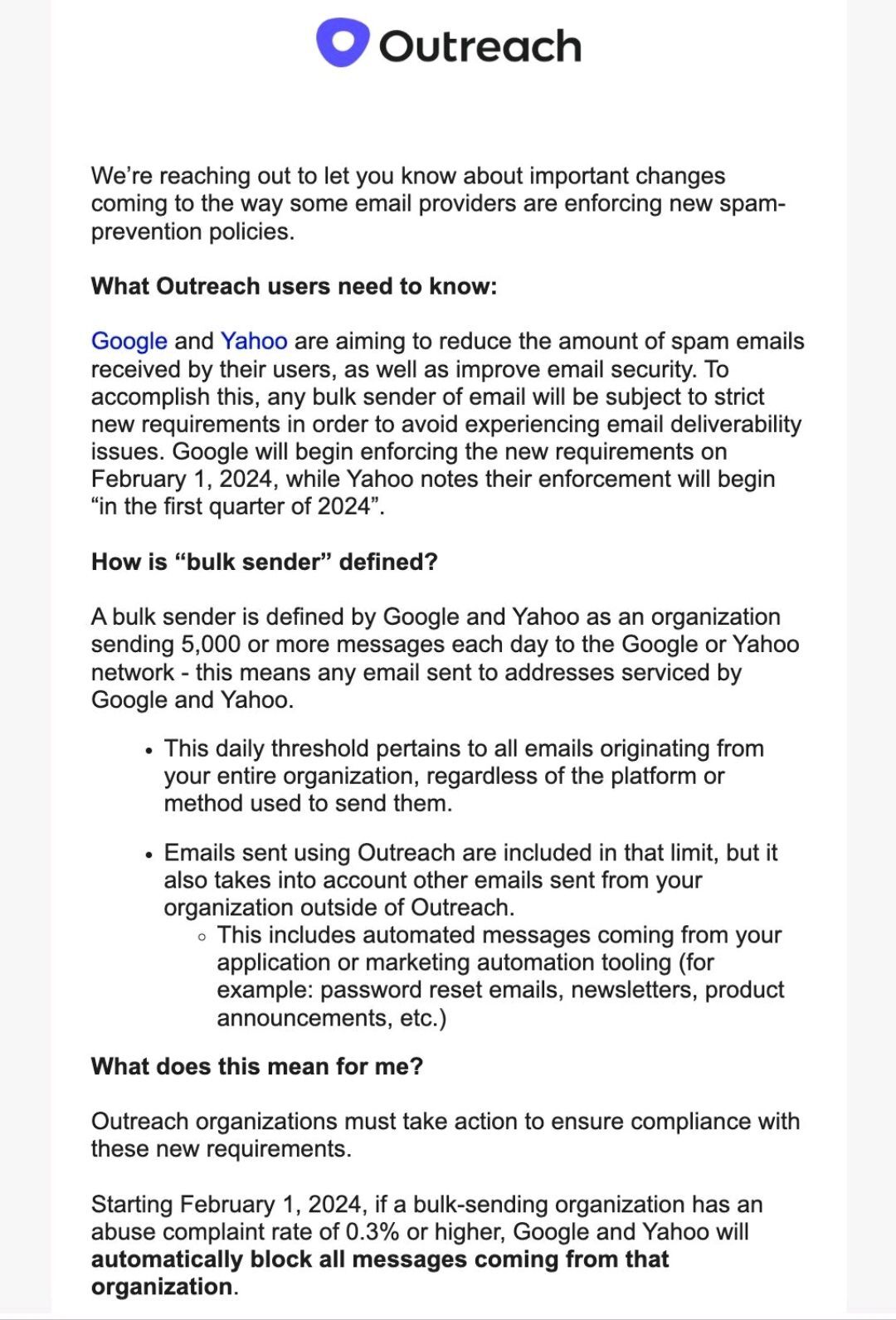Title
Earlier this year, Outreach.io (sales engagement platform) released a memo that raised many eyebrows. It referenced Google and Yahoo’s efforts to curb spam. Here’s what you might have missed beyond the headlines, and where you might need more clarity.
Starting in February 2024, Gmail and Yahoo will enforce new requirements for bulk senders, including authentication of emails, enabling easy unsubscribing, and staying under a spam threshold. The changes will impact how outbound prospecting is conducted, particularly for bulk email senders. The key changes include email authentication, one-click unsubscribing, prompt honoring of unsubscribes, and maintaining a low spam complaint rate. To comply with these new rules, sales and marketing teams need to implement specific strategies and tools.
What’s Important to Know:
“Bulk senders” aren’t the only audience affected. This applies not only to senders using Google and Yahoo services but also to lower-volume senders and Gmail recipients. You can't circumvent these rules by using a different service or domain.
The spam email threshold is 0.3% (1 of every 1,000 emails). Exceed this, and you risk having your user account or all emails from your domain blocked.
Prepare and update your authentication to ensure that your headers match or DKIM is in place, and make your content easy to subscribe to and engage with, as well as easy to unsubscribe from.
The enforcement date begins on February 1, 2024.
With these changes in mind, here's what you should do to adapt:
Implement Email Authentication: Use Sender Policy Framework (SPF), DomainKeys Identified Mail (DKIM), and Domain-based Message Authentication, Reporting, and Conformance (DMARC) to authenticate your emails. This ensures the legitimacy of your sending domain.
Incorporate One-Click Unsubscribe Links: Add easy, one-click unsubscribe options in your email sequences. This is essential to comply with the new rules and respect recipient preferences. When recipients choose to unsubscribe, ensure their requests are processed within 48 hours.
Maintain a Low Spam Complaint Rate: Craft compelling outbound email sequences to keep your spam rate below the 0.3% threshold set by Gmail and Yahoo.
Regularly Monitor Sender Reputation: Use tools like Google Postmaster to check your organization’s sender reputation and address any abuse complaints.
Align Sales and Marketing Strategies: Ensure that both sales and marketing teams are aligned in their email outreach strategies, considering the cumulative impact of emails sent from the same domain.
Adopt a Personalized Approach: Move away from the "spray and pray" methodology. Tailor your messages to suit the recipient's interests and needs.
Be Cautious with AI Assistance: While AI tools can aid in email composition, ensure they don’t inadvertently increase spam flags.
Consider Separate Domains for Different Campaigns: To manage sender reputations effectively, you might set up separate domains for marketing campaigns and cold outreach, bearing in mind the associated challenges.
Check my spam / IP / Domain ratings and credibility: Check Google postmaster tools: https://postmaster.google.com/u/0/managedomains
These upcoming changes by Gmail and Yahoo mark a significant shift in how outbound email marketing and prospecting will be conducted. Adapting to these changes requires a more targeted, personalized approach, emphasizing authenticity and respect for the recipient's preferences. By implementing these strategies, companies can continue to engage effectively with their audience while complying with the new email standards.
What does it all Mean? Experts Weigh-In

FAQs
Further Reading
Gmail and Yahoo will enforce new requirements for bulk senders starting in February 2024, including email authentication, one-click unsubscribing, prompt honoring of unsubscribes, and maintaining a low spam complaint rate. To comply with these rules, sales and marketing teams need to implement specific strategies and tools. This article provides important information and actionable steps to adapt to the upcoming changes, emphasizing a targeted, personalized approach and respecting recipient preferences.